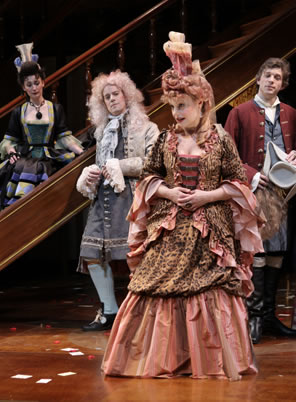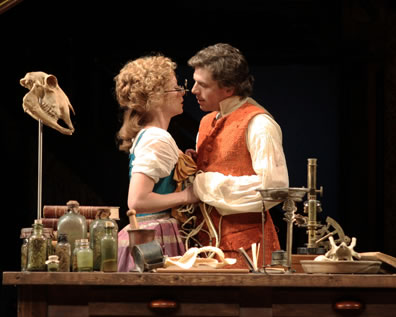The Gaming Table (adapted from The Basset Table)
Gambling at Cards, with Love,
In Life, and on Stage
By Susanna Centlivre, with additional material by David Grimm
Folger Theatre, Washington, D.C.
Thursday, February 16, 2012, F–8&10 (center right stalls)
Directed by Eleanor Holdridge
Eleanor Holdridge, during an after-performance audience talkback, described a day of rehearsal for The Gaming Table. The women were doing much work on a scene while the men mostly stood around waiting to speak their few lines. It was such a reversal from the norm of most classical plays that even the men noticed. “Now we know how you women feel,” one of them said.

Lady Lucy (Katie deBuys), Sir James (Michael Milligan), Mrs. Sago (Tonya Beckman Ross), and Ensign Lovely (Robbie Gay) in The Gaming Table at Folger Theatre. Photo by Carol Pratt, Folger Theatre.
The Basset Table by Susanna Centlivre is your typical Restoration comedy—a matching of wits in a tale of moral divides and muddied class distinctions—but, in this 1705 play, the women are the primary players. Ironically, Centlivre wrote The Basset Table as a sequel to her play The Gamester, which had a man as the central character. In returning that character to the stage, she surrounded him with a cast of strong female characters. It would be something like setting Shakespeare's Autolycus among Cleopatra, Olivia, Margaret, Imogen, and a character Shakespeare never thought up in one verbally rambunctious comedy. Director Holdridge, with David Grimm's adaptation (renaming the play The Gaming Table), then relied on the other male characters and an Escheresque set to layer a physical rambunctiousness on top of the wit-driven repartee in this rich and delightful production that coincided with the Folger's exhibition “Shakespeare's Sisters: Voices of English and European Women Writers, 1500–1700.”
From the Jessica Ford–designed costumes (richly detailed manteau dresses, ornate cassock coats, and extravagant periwigs) and the players' manners and movements, you might think you were watching a Restoration-era painting come to life from the Folger collection. However, with the dresses including leopard print and bright turquoise and yellow, the repartee including an inordinate number of penis puns, and the characters' mannered interactions including many puzzled pauses, you might also think you were watching a Kristen Wiig comedy. Then there's Marion Williams' set of Lady Reveller's home. At first take, the stage appeared to be the foyer of a 1700 English townhome. Not only were the Elizabethan stage's wooden pillars left untouched to appear as part of this noble décor, but the theater's balcony balustrade also melded into the upper landing of Williams' set, and a matching wooden staircase descended across the field of view at an angle. Other stairways crisscrossed the set behind the main one adding depth to the illusion of a house. But on closer inspection, you would realize it's all an illusion, as some of those staircases are upside down, a chair hangs upside down on a wall, and below the chair is an upside-down light sconce.
Holdridge's inspiration for the setting was not 17th century London but 21st century Las Vegas, where casinos create a world with no ups or downs and hard-to-locate exits. In fact, a couple of characters complained that they could not find their way through and out of Lady Reveller's house. Meantime, Nancy Schertler's lighting gave the audience no clue of the time of day; we got from dialogue that the first portion of the play took place after an all-nighter, but otherwise the characters seemed to be living a perpetual 24-hour day.
Las Vegas is the more apt source for the staging because The Gaming Table is about gambling. Characters not only play their cards and wager their purses in the games of basset hosted by Lady Reveller (Julie Jesneck), they gamble with their hearts and their estates in pursuit of good fortune. The centerpiece scene of the game itself was as confusing to modern audiences as baseball might be to these British characters, but we understood the ecstasies of winning and the agonies of defeat, the glimpses of good luck obliterated by runs of bad luck, and how such runs gave rise to accusations of cheating. We saw the same play out, too, in Lord Worthy's frustrated courtship of Lady Reveller, in Sir James Courtly (i.e., the Gamester) looking for a winning hand to play in his attempted seductions of various women, and in the sleight-of-hand that cheats Sir Richard Plainman out of marrying off his daughter against her will.
At the center of the action is Lady Reveller, the hostess who sees basset as a moneymaking enterprise and her means of accessing all levels of London society. A level-headed businesswoman on the one hand, she could turn on coy flirtation as necessary, and though seemingly flighty in those moments, Jesneck gave her a core of strength that kept her from bending to any man's will, whether it was Lord Worthy's incessant suit, Sir James' sexual advances, or the interferences of her basset games by her uncle, Sir Richard Plainman, who actually owned the house. She also did moral battle with Lady Lucy (Katie deBuys), who preached against both the gambling and the consorting with libertines, but who herself contended with her own pangs of want for Sir James, the most libertine of all. Emily Townley played Alpiew, Lady Reveller's maid and confidante and the one who managed the house, the gaming, and the gate to Lady Reveller's heart.
Centlivre steps outside female archetypes most notably with two other characters. Valeria (Emily Trask) is Plainman's daughter, described by him as a country girl; but she is, in fact, a budding scientist, naïve about men, perhaps, but only because she preferred chasing frogs, studying worms, and dissecting any animal she could catch. Magnifying lens attached to her glasses, Trask's Valeria took more of an anatomical interest in men as specimen than as potential lovers. Her opposite was Mrs. Sago (Tonya Beckman Ross), a gambling addict scamming her ever-doting husband, clownishly played by Darius Pierce. The Sagos as a couple were something of a reversal of standard gender types, with him innocently enabling his wife while she cold-heartedly schemed him out of money that she then lost at the tables, caught up in her lust for good luck and Sir James.

Valeria (Emily Trask) and Ensign Lovely (Robbie Gay) bond at Valeria's lab table, where they share a discovery about worms in the production of The Gaming Table at the Folger Theatre. Valeria prefers scientific learning to romance in Susanna Centlivre's 1705 comedy. Photo by Carol Pratt, Folger Theatre.
The men, too, played against stereotypes, especially Lord Worthy (Marcus Kyd), who wore his passion on his sleeve, chest, back, and wig of flowing black locks. Kyd's Worthy responded to each rebuff from Lady Reveller with anguished tears, literally crawling into a fetal position as he sobbed on a chaise lounge. Sir Richard Plainman (Michael Willis) was the typical pantaloon, intent to match his daughter with a seaman (a pun Willis milked well), and he set his sights on the bombastic Captain Hearty (Michael Glenn), who, under his veneer of man-your-guns-maties zeal, was perhaps the most emotionally stable and common-sense character of the whole lot. He and Sir James team up to aid Valeria's true love, Ensign Lovely (true love as in the only man she'd consent to be with rather than merely dissect and study). In the one portion of the play where the men wrested the plot and comedy from the women, Robbie Gay's wide-eyed, bumbling Ensign Lovely pretended to be a pirate-like sea captain even more bombastic than Hearty to scam Sir Richard Plainman into marrying his daughter to him.
Holdridge assembled a strong corps of actors of both genders to carry out the witticisms and physical humor, both grand and subtle, with Michael Milligan as Sir James Courtly walking the tightest rope. The gamester in blue, jeweled coat and long wig of white curls (very Handel-like in appearance), Milligan maintained courtly refinement amid the ridiculous as he maneuvered all his plots to bring the pairs of lovers to successful consummations. His studied precision earned many laughs, exemplified in the final rendering of one of the play's running jokes, Captain Hearty spitting every time someone mentioned the French. During the scamming of Plainman, the French were named, Hearty spit, Plainman spit, and then Ensign Lovely, pretending to be the privateer, snorted up a mighty expectorate. All eyes then turned to Sir James, who daintily petuied and dabbed the dribble on his lip with his handkerchief.
Centlivre was one of a few female playwrights of the Restoration era, of whom Alphra Behn is best known. But as the Folger has dusted off this gem (and the Shakespeare Theatre Company is dusting off French classics in new adaptations), it's obvious that she is part of a vein of dramatic riches running between Shakespeare and Shaw that is worth more mining.
Eric Minton
February 22, 2012
Comment: e-mail editorial@shakespeareances.com
Start a discussion in the Bardroom


